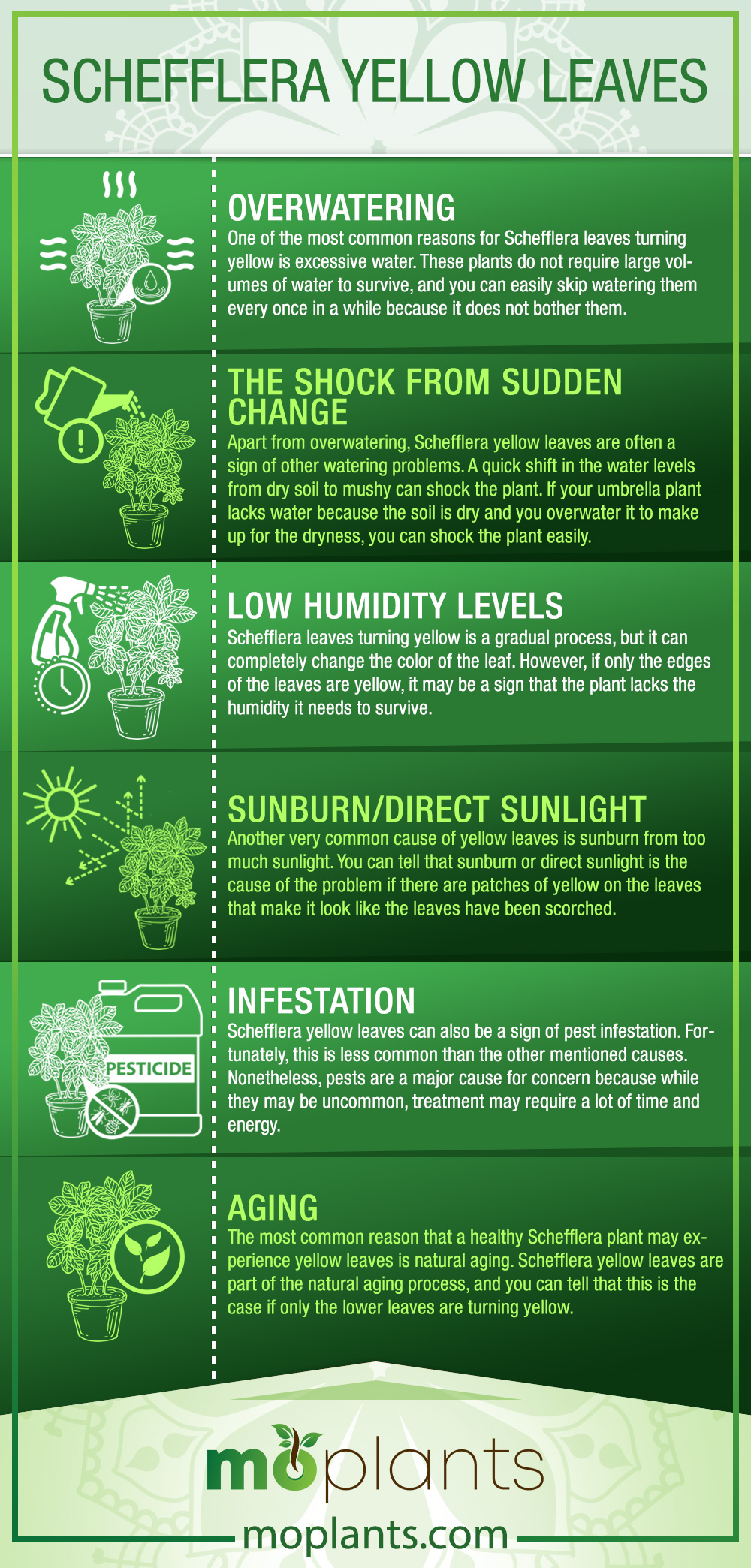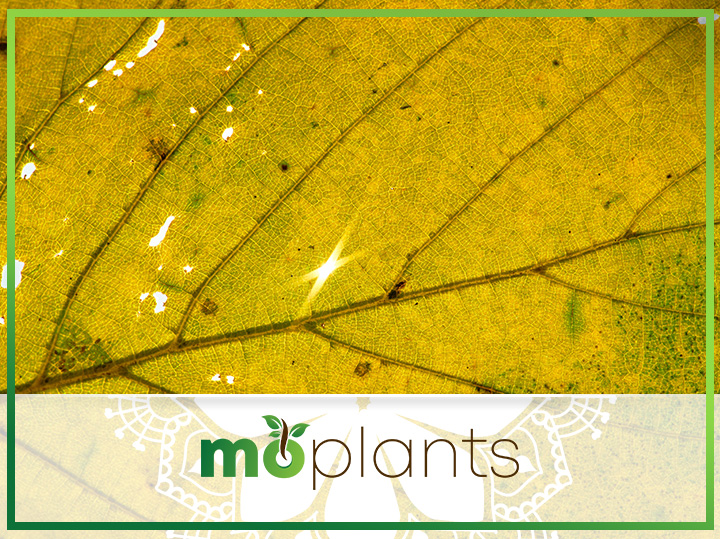Schefflera is a popular houseplant around tropical regions because it is fairly easy to grow in a wide range of conditions and offers a unique and fun texture to any household. It has divided hand-like leaves and can look pleasing in any home setting, including your bedroom, dining room, living room, or yard.
Sometimes, Schefflera owners complain about Schefflera leaves turning yellow. While this can be the result of an internal natural process, it may likely be a sign of an external issue. This can be concerning for most owners because they don’t know what is causing the color change.
Today, we will discuss Schefflera yellow leaves, the most common causes of this outcome, and how you can prevent your Schefflera leaves from turning yellow.
What Exactly Is Schefflera?
Schefflera is a flowering plant from the Araliaceae family and has somewhere between 600 to 900 species representing nearly half of the Araliaceae family. These plants have woody stems and palmately compound leaves (palm-like structure) and can grow anywhere between 4 to 20 meters tall.
This common houseplant has graceful, drooping, finger-like leaves in a palm structure that give the appearance of an umbrella, which is why it is popularly known as the umbrella plant. Umbrella is also easier to relate to than “Schefflera,” but ‘umbrella’ is a term used to describe various species of the Schefflera plant.
The plant is one of the most commonly used houseplants for Feng Shui, which is what popularized it in the US nearly half a century ago. In China, it is also known as acupuncture for your home. The belief is that the leaf fingers can capture positive energy.
The plant is also believed to attract wealth for the residents of the home. While leafy green umbrella plants look great in the home and may attract wealth and positive energy, Schefflera yellow leaves are not a good sign for the plant or a good look/energy for your home.
Schefflera Yellow Leaves
There are quite a few reasons for Schefflera leaves turning yellow, which is why you need to know the correct reason or cause before you go about making changes to how you care for the plant.
Once you know the cause, you can start taking the necessary steps to stop the progression of yellowing or of the number of yellow leaves and recover the plant back to its healthy green self.
Here are some of the most common causes of Schefflera yellow leaves, how you can identify them, and most importantly, how you can fix them.
Overwatering
One of the most common reasons for Schefflera leaves turning yellow is excessive water. These plants do not require large volumes of water to survive, and you can easily skip watering them every once in a while because it does not bother them.
Accidental overwatering could easily be the reason the leaves are turning yellow, or perhaps the drainage is blocked, causing the water to buildup and rot the roots. If the roots are harmed, the plant cannot get the nutrients it needs to survive, causing the leaves to turn yellow.
The easiest way to test waterlogged soil is through a simple smell test. Get closer, and smell the potting soil for a musty or damp odor. If you smell it, it is likely that the plant has been waterlogged for some time. Another effective way to test this is to remove the plant from the pot and check to confirm.
If you find the potting soil to be clumpy or waterlogged, you should replace it immediately. To prevent overwatering in the future, simply monitor and log the moisture levels of the plant. This will help you understand how frequently you should water your Schefflera plant.
The Shock from Sudden Change
Apart from overwatering, Schefflera yellow leaves are often a sign of other watering problems. A quick shift in the water levels from dry soil to mushy can shock the plant. If your umbrella plant lacks water because the soil is dry and you overwater it to make up for the dryness, you can shock the plant easily.
The sudden change is too much for the plant to bear, and it results in yellow leaves. The best approach is to increase the frequency and volume of watering gradually to avoid sending your Schefflera into shock.
Low Humidity Levels
Schefflera leaves turning yellow is a gradual process, but it can completely change the color of the leaf. However, if only the edges of the leaves are yellow, it may be a sign that the plant lacks the humidity it needs to survive.
As mentioned previously, Schefflera plants are not difficult to maintain. They can grow healthy and lush green in normal humidity levels. However, if the edges are turning yellow, the air might be particularly dry. A lack of ventilation or regular heating during winters may be causing dryness in the air.
A simple solution to improve humidity levels is to mist the Schefflera. Use a regular spray bottle to regularly mist a few times a week. The best time to mist is around mid-morning because it gives enough time for the liquid to evaporate and increase humidity levels before nightfall.
You should also avoid misting the plant during the evening because the colder night temperatures will prevent timely evaporation and dampen the leaves, causing them to rot easily in the cold. Another easy fix is to create a pebble tray.
Simply add enough pebbles in a tray to cover the surface and pour water halfway up to the height of the pebbles. Then, place your Schefflera on top of the pebbles. The warm pebbles will promote evaporation of the water around the plant and slowly increase humidity levels.
Sunburn/Direct Sunlight
Another very common cause of yellow leaves is sunburn from too much sunlight. You can tell that sunburn or direct sunlight is the cause of the problem if there are patches of yellow on the leaves that make it look like the leaves have been scorched.
One of the things that make the umbrella plant such a common and sought-after houseplant is that it can grow happy with or without much sunlight. While they enjoy indirect sunlight, direct sunlight is not sustainable for them, especially during the long sunny days of summer.
If you see yellow patches on your Schefflera, the simplest solution is to trim the most affected leaves from your plant and move it somewhere with little or no direct sunlight.
Infestation
Schefflera yellow leaves can also be a sign of pest infestation. Fortunately, this is less common than the other mentioned causes. Nonetheless, pests are a major cause for concern because while they may be uncommon, treatment may require a lot of time and energy.
Tiny insects like scale insects, spider mites, or aphids damage leaves and hide on plants, making them tough to spot. Infestation can take a toll on any plant, including causing yellow leaves on your umbrella plant.
The Schefflera leaves may also exhibit tiny holes, indicating that infestation may be causing yellow leaves. To be sure, you must spot the pests using a magnifying glass. You may find them in some common hiding spots like the stem joints or the undersides of leaves.
Once you find pests, you should immediately isolate your Schefflera from other plants and check other plants for infestation. While you might think that only nearby plants would be affected, pests can travel to far-off plants in many different ways, including via the wind, humans, or tools.
So, if you find pests on your Schefflera plant, it is always best to check other houseplants and isolate them from uninfected plants.
Treatment for pests varies greatly, but once you have isolated your Schefflera, identify the worst affected leaves and trim them to minimize the infestation and its spread. Then, use high-quality pesticide, and apply it to your umbrella plant according to the manufacturer’s instructions.
Often, experts recommend treating other plants that have been in contact with the infested plant as well. Other times they recommend treating all the plants of the same species if the infestation is specific to that plant family.
This helps eliminate any overlooked infestation and prevents the further spreading of pests. However, depending on the variety of your houseplants and other factors, this wide range of treatment may not be ideal for your plants.
You should consult your local nursery or a professional before you decide to implement mass pesticide treatments on a variety of seemingly healthy plants. The best approach for excessive or even light infestation is to hire a professional to do it correctly.
Although, if you catch an infestation early, there is a high chance that you can restore your Schefflera plant back to normal yourself. On the other hand, if the infestation has spread to half or more of the Schefflera, restoring its health is quite unlikely.
When infestation becomes out of control and treatment is not an option, you have to remove the plant from your home and dispose of it correctly to prevent further spreading.
Aging
The most common reason that a healthy Schefflera plant may experience yellow leaves is natural aging. Schefflera yellow leaves are part of the natural aging process, and you can tell that this is the case if only the lower leaves are turning yellow.
This is not a cause for concern because as time passes, Schefflera plants drop a few of their oldest leaves to spend more nutrients and energy on growing newer, bigger, and healthier leaves. When the lower leaves turn yellow, you should monitor the frequency at which the dying leaves are dropped to confirm natural aging.
Schefflera plants typically only drop 1 or 2 of their oldest leaves every few months. If the drop rate is higher than this or if there is a progression in the number of yellow leaves, especially at higher levels of the plant, aging may not be the cause.
This means you must go through the abovementioned common causes, correctly identify the cause, and treat your Schefflera plant accordingly.
Infographic

Final Thoughts
Hopefully, the mentioned most common causes, identifiers, and solutions of Schefflera yellow leaves would help you nurse your beautiful Feng Shui umbrella plant back to normal. The most important thing is to catch the problem early on so you can take action to prevent excessive or irreversible damage.
Make sure you take the necessary steps to identify the root cause before jumping to solutions properly. Early diagnosis also means less time, effort, and fewer changes to your Schefflera plant. We always recommend that owners trim away the worst affected leaves because it prevents the plant from wasting nutrients, energy, and resources on keeping those dying leaves alive.
When you trim such leaves, the plant can instead allocate all those resources to growing newer, greener, healthier leaves.
Unfortunately, sometimes Schefflera plants are too far gone to recover from the yellowness or damage. In such extreme cases, treatment or any of the mentioned solutions may not be enough to revive or recover the plant.
If this happens and you can’t seem to solve the issue, your best option is to propagate the Schefflera to save the healthier parts of the plant. Although, if an infestation has occurred in the dying plant, you need to be careful not to use any infested parts for propagation.
If you want to learn more about Schefflera yellow leaves, causes, solutions, plant care, treating common issues, or about our wide range of growing guides, please visit Mo Plants today.

